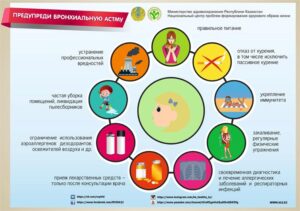World Asthma Day “Live without Asthma”
Bronchial asthma is a global health problem and is one of the most common chronic diseases. According to WHO, about 5% of the world’s adult population and 10% of children suffer from bronchial asthma. This is the most common chronic disease that develops in childhood.
According to the forecast of scientists, by 2025 the number of asthma patients will increase by 100 million people, in the second half of the century every second child will suffer from asthma. The disease can occur at any age, about half of patients develop the disease before the age of 10, and another third – before the age of 40. There are 2 times more boys than girls among children with bronchial asthma. By the age of 30, the sex ratio is leveled.
Hereditary predisposition, poor ecology, poor nutrition, frequent allergic reactions in childhood, obesity, smoking, parasitic liver diseases, dysbiosis and other diseases are of great importance in the development of bronchial asthma. Thus, natural allergens in the form of pollen, vehicle exhaust fumes, tobacco smoke, chemicals in the workplace, at home, dust mites that live in carpets, pillows, as well as pet hair can lead to irritation of the respiratory tract.

A reminder for parents
Risk factors for the development of bronchial asthma in children: Predisposing factors:
Allergy; Heredity (BA in parents, close relatives).
Sensitizing factors:
Household allergens (dust, dust mites); Animal and insect allergens; Fungal allergens; Pollen allergens; Food allergens; Medicines; Viruses; Chemicals.
Factors contributing to the occurrence of asthma
Viral infections; Severe pregnancy in the mother; Poor nutrition; Tobacco smoke
Factors causing exacerbation of AD – triggers
Allergens; Acute respiratory viral infections; Physical and psycho-emotional stress; Climate change; Environmental impacts
Information for parents
It is the parents who should teach their child to keep the room clean, practice regular ventilation and frequent wet cleaning. All this complex of measures is aimed at achieving one goal – preventing the accumulation of dust and pathogenic bacteria in the living room.
Primary prevention is of particular importance for people who belong to the high-risk group. Doctors constantly warn about the high probability of developing bronchial asthma, the following categories of people:
– Smokers.
– People with a genetic predisposition to asthma.
– People who have suffered from atopic dermatitis.
– People suffering from any form of allergy (from food allergies to seasonal and drug allergies) or have a predisposition to it.
– People with pronounced symptoms of bronchoobstructive syndrome, which is a consequence of various diseases of the respiratory system (usually colds).
It is people from the high-risk group who should pay special attention to compliance with primary prevention measures for bronchial asthma.
Primary prevention includes:
– Improvement (as much as possible) of the environmental situation (temporary or permanent change of place of residence).
– Regular cleaning of premises, it is necessary to minimize the number of carpets, books and soft toys in living rooms (especially in bedrooms).
– Compliance with the rules of personal hygiene.
– If possible, do not have pets.
– The use of hypoallergenic household items.
– Proper and healthy nutrition, consumption of high-quality products with minimal use of food additives.
– Minimal use of various aeroallergens – from deodorants and perfumes to air fresheners.
– Elimination of the factor of unsuitable working conditions. If the symptoms of bronchial asthma increase, it is advisable to change jobs altogether.
– Timely treatment of respiratory infections.













